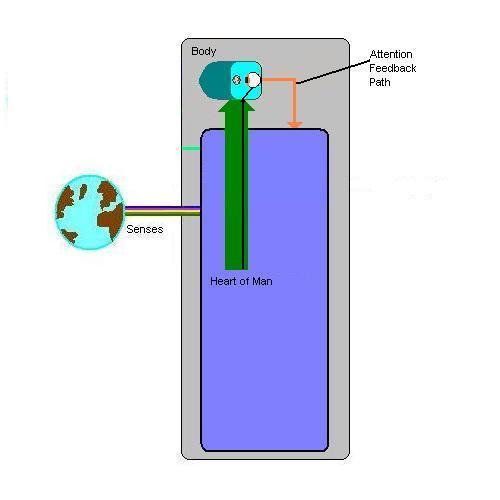Models of the Human Mind: The Biblical Heart Model
Here is my best interpretation of the human "heart" as viewed by the Bible Writers and tweaked to account for the "edge" cases that were cited in the previous three pages:

This is based on an observation made by Owen Barfield in his book "What Coleridge Thought". The 2006 Barfield Press edition of his 1971 work has the following paragraph on page 21 after some quotations he cites from Coleridge:
Tinted glasses make the clearest blue sky look leaden and overcast. Coleridge will continue to be called 'cloudy' even by his admirers, because he will continue to be misinterpreted by readers who are not willing to grasp, and to remember once they have grasped, the elementary principles which consciously permeate almost every other sentence he constructs, and which it is hoped that the foregoing quotations sufficiently illustrate. These are: first, that thinking is an act. Secondly, that it is normally, though not necessarily and always, an unconscious act. Thirdly, though we are not normally conscious of the act, we are normally conscious of the product of of the act (which we call 'thoughts'), and indeed it is this, which actually constitutes our self-consciousness as human beings.
I have underlined the portions of the quotation that are relevant, which I summarize as follows (and without the conditionalities Barfield cites): What we call thinking is not actually thinking. What we "call" thinking is merely the perceiving of thoughts. The thoughts themselves are generated by what we moderns would call the unconscious, but which the Bible Writers called the "heart of man".
Note that all the sensations, including the body sense, is routed into the heart, which performs a huge amount of pre-processing of the signals. This is the modern contribution to the "Heart of Man" model. These resultant thoughts, including thoughts that generates the illusion of having the sense of taste, touch, sight, smell, and hearing, are thrown up into the part of the brain that we would call the "conscious" mind via what I call "the bitstream" (the green arrow), but which one could call the "display" portion of the mind. It is like a crt display. The "eye" in the model is "us", the "I" of the person. The "I" perceives the thoughts on the display, and chooses to focus on one of the possible thoughts being presented. This choice is fed back into the heart, which uses that feedback to throw "related" thoughts up to the "display" via "the bitstream". (The analogy of the display is a bit strained: it is more like a three dimensional stage on which the "I" is an actor.)
Note that there is a black arrow within the yellow arrow, and impacting the perceiving "I", rather than the "crt". This depicts the contribution of the biblical model. Recall what Jesus said in Matthew 15:10-18:
10 And he called the multitude, and said unto them, Hear, and understand: 11 Not that which goeth into the mouth defileth a man; but that which cometh out of the mouth, this defileth a man.....15 Then answered Peter and said unto him, Declare unto us this parable. 16 And Jesus said, Are ye also yet without understanding? 17 Do not ye yet understand, that whatsoever entereth in at the mouth goeth into the belly, and is cast out into the draught? 18 But those things which proceed out of the mouth come forth from the heart; and they defile the man. 19 For out of the heart proceed evil thoughts, murders, adulteries, fornications, thefts, false witness, blasphemies: 20 These are the things which defile a man: but to eat with unwashen hands defileth not a man.
In the model, the eye represents the "man" that is underlined in the above passage. The black arrow represents the "evil thoughts, murders, adulteries, fornications, thefts, false witness, blasphemies" that proceed from the Heart of Man and affect the man. These thoughts are not sensations coming from the senses, but are perceived by way of simulated sensations.
Prev Page Next Page
Pg-1 Pg-2 Pg-3 Pg-4 Pg-5 Pg-6 Pg-7 Pg-8 Pg-9
Leave Feedback for This Page